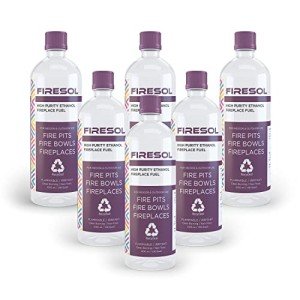Bio ethanol fuel is a fantastic choice for those who want a clean and efficient way to enjoy a cozy fire. It burns cleanly, producing little to no smoke or soot, so you can breathe easy while you relax. Plus, it’s super easy to use—just pour it into your bio ethanol fireplace, light it up, and enjoy the warmth without the hassle of traditional fuels.
Bio Ethanol Fuels
Discover clean and efficient energy solutions for your modern fireplace with our selection of bio ethanol fuels
Product List







Roundfire 0.5L Bioethanol Fuel
Roundfire
Product Review Score
4.84 out of 5 stars
56 reviews$24.99 $18.99





As concerns over climate change and fossil fuel dependency continue to mount, the search for sustainable energy solutions has gained unprecedented urgency. Among the various alternatives, bioethanol fuels have emerged as a promising contender. Derived from biomass, bioethanol not only serves as a clean-burning fuel but also offers a viable pathway to reducing greenhouse gas emissions. This guide delves into the intricacies of bioethanol fuels, their production methods, advantages and disadvantages, and their potential impact on our energy landscape.
What is Bioethanol?
Bioethanol is a renewable alcoholic beverage produced from the fermentation of sugars derived from various biomass sources—mainly plants. It is primarily used as a fuel component in transportation, and it can be blended with gasoline to create different fuel mixtures, commonly referred to as E10 (10% ethanol) or E85 (85% ethanol).
Table 1: Common Feedstocks for Bioethanol Production
| Feedstock | Source | Fermentation Sugar | Common Uses |
|---|---|---|---|
| Corn | Annual crop | Starch (converted to sugar) | Fuel, beverages, industrial |
| Sugarcane | Tropical crop | Sucrose | Fuel, beverages |
| Cellulosic biomass | Various (e.g., switchgrass, wood waste) | Cellulose (requires pre-treatment) | Fuel, energy production |
| Potatoes | Tuber crop | Starch | Fuel, food products |
| Wheat | Cereal crop | Starch | Fuel, animal feed |
Production Methods
The production of bioethanol typically involves several steps that convert biomass into usable fuel. These steps can be broadly classified into two categories: conventional processes and advanced biofuel technologies.
Conventional Processes
-
Fermentation: Sugars from feedstocks are fermented by yeast. This process converts the sugar into ethanol and carbon dioxide.
-
Distillation: The fermented mixture is distilled to separate ethanol from water and other by-products.
-
Dehydration: Ethanol is dehydrated to remove any remaining water, resulting in pure bioethanol.
Advanced Biofuel Technologies
-
Cellulosic Ethanol Production: This method breaks down complex sugars in non-food biomass, such as agricultural waste, using enzymes and heat, making it more environmentally sustainable.
-
Sugarcane Ethanol: This method utilizes the juice extracted from sugarcane for fermentation, a technique that is highly efficient in tropical regions.
Table 2: Comparison of Production Methods
| Method | Feedstock | Yield Efficiency | Environmental Impact | Advantages |
|---|---|---|---|---|
| Conventional | Corn, Wheat, Sugar | Moderate | Higher reliance on agriculture | Well-established technology |
| Cellulosic Production | Agricultural waste | High | Lower land use | Utilizes waste materials |
| Sugarcane Ethanol | Sugarcane | High | Low carbon emissions | Highly efficient |
Advantages of Bioethanol Fuels
-
Renewable Source: Bioethanol fuels are derived from renewable resources, making them more sustainable than fossil fuels.
-
Reduction in Greenhouse Gas Emissions: Burning bioethanol produces lower greenhouse gas emissions compared to gasoline, contributing to improved air quality.
-
Energy Independence: Utilizing domestically-produced bioethanol can reduce reliance on foreign oil supplies, enhancing energy security.
-
Job Creation: The bioethanol industry has the potential to create jobs in agriculture, production, and distribution sectors.
-
Economical: The use of domestically-sourced bioethanol can stabilize fuel prices, making it a financially viable alternative.
Disadvantages of Bioethanol Fuels
-
Competition with Food Production: The demand for biofuel can divert agricultural resources away from food production, potentially leading to food shortages.
-
Land Use Concerns: Large-scale bioethanol production can lead to deforestation and habitat destruction.
-
Energy Input vs Output: Some bioethanol production processes consume more energy than the fuel yield they produce, raising efficiency concerns.
-
Infrastructure Limitations: Existing fuel distribution infrastructure may not be equipped to handle high concentrations of bioethanol.
-
Use of Fertilizers and Pesticides: The farming of biofuel crops often relies on chemical fertilizers and pesticides that can have adverse environmental effects.
Future Outlook
The future of bioethanol fuels is contingent on technological advancements and regulatory support to enhance production efficiency and sustainability. Innovations in enzyme technology and fermentation processes are paving the way for more sustainable bioethanol production from unconventional feedstocks. Policymakers are also increasingly recognizing the importance of biofuels in a balanced energy portfolio and are incentivizing their use through renewable energy standards and subsidies.
Frequently Asked Questions (FAQ)
1. Is bioethanol safe to use in my vehicle?
Most modern vehicles can run efficiently on bioethanol blends, especially those designed for higher ethanol-content fuel, such as E85. However, it is advisable to check your vehicle's specifications.
2. What are the environmental impacts of bioethanol production?
While bioethanol has the potential to lower overall carbon emissions, its production can have negative effects such as land use change and reliance on chemical fertilizers. Sustainable practices can help mitigate these impacts.
3. Can bioethanol be produced from waste materials?
Yes, cellulosic bioethanol can be produced from agricultural and industrial waste, providing a sustainable and environmentally friendly source of fuel.
4. How does the energy output of bioethanol compare to gasoline?
While the energy content of bioethanol is slightly lower than gasoline, blending it with gasoline can often enhance the overall energy performance of the fuel.
5. Are there regulations governing bioethanol use?
Yes, many countries have established regulations and incentives to support the production and use of bioethanol as part of their renewable energy goals.
Bioethanol fuels present a potent solution to the challenges posed by fossil fuel usage and climate change. As research and technology advance, the potential to produce bioethanol sustainably and efficiently will only grow. Through responsible management and innovation, bioethanol fuels can play a crucial role in shaping a cleaner, more sustainable energy future.